How to choose the right stair part accessories: end caps, wall brackets, fixing kits and more
Stair part accessories bring the whole look of a staircase together with stylish finishing touches. Finding the right accessories can help to bring together the style of your staircase, and can even enhance and complement your spindles, handrail and newel posts.
Here we explain more about the different handrail accessories available – such as end caps, wall brackets and cross-grain pellets. We also discuss how to choose the right designs and materials for you.
Click on a link to jump to each section:
Read about the different materials and styles of end caps.
Read your options of handrail wall brackets and their uses.
Find out more about the benefits of cross-grain pellets and your options.
Read about what is included in fixing kits and how they can be used.
Find out what cover buttons are and their benefits.
Read your options of wall patrices and how they can be used.
Find out more about the benefits of stair treads and risers cladding.
Read about the uses of string veneer and the materials it is available in.
What are end caps, and what are the different material options?
End caps are used to add a decorative finish to the ends of wooden handrails and are available in a range of metals including:
The variety of different styles and metals means you will find a pair that suits your home décor perfectly. End caps for wooden handrails are easily secured in place with screws.
You can create the perfect bespoke look for your stairs by pairing the end caps and brackets of your choice with one of our wooden handrails. Wooden handrails are available in:
View the full range of handrail end caps here.
Traditional end caps for mopstick handrails
These traditional end caps are suitable for 54 mm mopstick handrails.
Slim end caps
Slim end caps are 13 mm deep and are available in black, brass or chrome effect.

Medium end caps
These slightly thicker end caps are 25 mm deep and are available in black, brass or chrome effect.

Filigree end caps
Filigree stair end caps are 43 mm deep and feature ornamental metalwork to add some decadence to your staircase handrail. These are available in black, brass or chrome effect.

Antique brass end caps will give your hallway a touch of luxury. This traditional banister end cap in brass can be used alongside a matching bracket to complete the look.


Contemporary end caps
Contemporary style end caps can instantly bring your staircase right up to date. Featuring bold shapes and a flawless finish, the eye-catching sheen of modern end caps is enhanced further when paired with matching brackets.

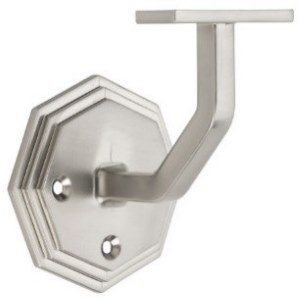
The geometric design and brushed nickel of this contemporary banister end cap and matching bracket are timeless and on trend.
As well as modern stair end caps for mopstick handrails, end caps can also be used to complete the look of the on the HR and Elements style handrails.


Brushed nickel HR profile handrail end cap
Choosing the best end cap material for your handrail
Having a cohesive colour scheme can create a more traditional, homely look. Woods such as oak or pine are considered medium to warm in tone, so pairing them with the luxury look of brass (as pictured) creates an elegant statement.
Of course, a dramatic contrast of colour can be effective, such as matching a dark hardwood with bright reflective chrome. Alternatively, for paler wood, a simple black end cap can create a pleasing look, with end caps highlighting the handrail to draw attention.
Materials that are cooler in tone can be used to create a variety of effects: from a calming oasis in the home, to a clean-cut appearance in office or work settings.
Read our full guide to choosing handrail end caps here.
Do you want to know more about how to find the best end cap for you? Contact us today.
Why are handrail wall brackets used, and what are the different options available?
Handrail brackets are used to fix wall-mounted handrails to a wall. You will need at least two brackets to fit a handrail—one each at the top and bottom—and additional brackets to support the middle of the handrail. As a general rule, you should space handrail brackets no more than a metre apart. If you need assistance in fitting a handrail bracket, please contact us today.
The majority of handrail wall brackets can be fastened onto the underside of the handrail provided it has a flat surface.
There are a number of different styles and finishes available, allowing you to opt for a simple bracket in a neutral finish, or something a little more striking, such as a black wall bracket or a bracket in an ultra-contemporary style.
Contemporary wall bracket in gun metal
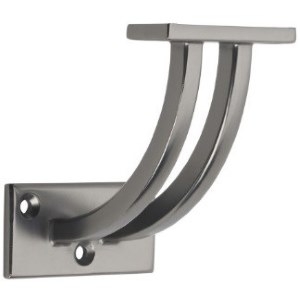
Fusion handrail bracket in chrome

Brushed nickel wall bracket that will complement the look of most staircases. This design is also available in chrome, brass and black
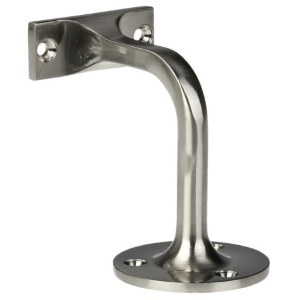
To ensure the handrail is as secure as possible, you may want to use wall patrices to fix the wall-mounted handrail to the wall.
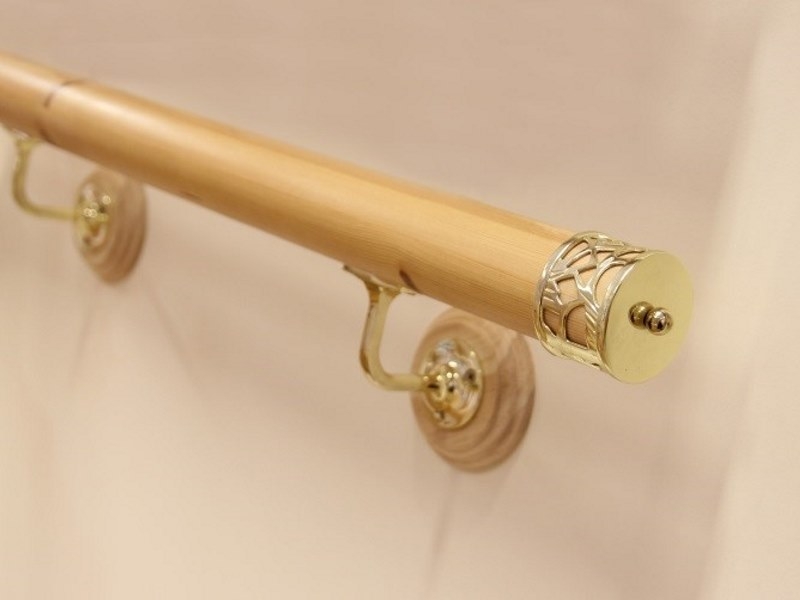
Mopstick handrail with end cap, brackets and wall patrices

Pig’s ear handrails don’t require brackets as they are fitted flush to the wall and cross-grain pellets are used to cover any drill holes. You can find out more about fitting pig’s ear handrails here.
Read our full guide to choosing handrail brackets here.
Finding the right wall bracket material for you
Different handrail bracket materials go well with different types of woods. Chrome works particularly well when teamed up with pale wooden handrails, such as oak or pine. Visit our handrail brackets advice page to find out which wood you should pair with your handrail bracket.
Choosing a wall bracket design
You may want a bold option such as the octagonal wall bracket, or a more subtle option such as the round wall bracket. Specific designs work better with different style homes. If you have a more modern home, you may want a more sophisticated design, and if you have a traditional style home, you may want to opt for a more antique decorative design.
What are the benefits of cross-grain pellets, and what are your options?
Cross-grain pellets are used in joinery to hide screws and bolts by filling in drill holes. Once inserted, they can be trimmed down and sanded to create a smooth surface.
By matching the cross-grain pellet wood with the same timber as your handrail, you can create a flawless finish.

A number of different materials are available for cross gain pellets including:
-
pine
-
ash
-
oak
-
hemlock
-
dark hardwood
-
walnut
Cross-grain pellets are a taperd pellet that measure 12.7 mm at the centre of the pellet. They are smaller at the bottom than the top so they can be easily inserted into drill holes.
What is included in fixing kits?
Fixing kits contain everything you need to complete your staircase. They are available with cover buttons to match the wood on your balustrade. Choose from the following kits:
Handrail to newel post fixing kits

Straight landing slipfix fixing kit

Shop our full range of staircase fixings here.
Cover buttons
Cover buttons fit on top of drill holes in newel posts to provide a smart finish. They are available in a range of different woods so you can match the correct cover button with your newel post. At Jacksons, we offer a range of materials; including pine cover buttons, oak, dark hardwood, and more.
Shop our full range of cover buttons here.
Peg dowel
A peg dowel is a cylindrical wooden rod at the bottom of a newel post that is used to secure the newel post to the newel base. When fitting a newel post, the dowel is coated in adhesive and inserted into a hole in the newel post’s base. These pegs are 50mm in diameter.
What is a wall patrice, and when is it necessary?
A wall patrice is a circular wooden disc fixed to a wall to provide a base to which handrail brackets can be secured. Although handrail brackets can be fitted directly to a wall, patrices give the bracket extra support, as well as adding a smart finishing touch to the staircase as a whole.
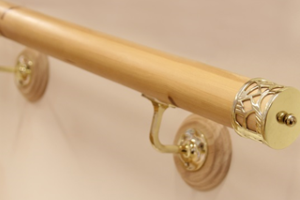
Handrail bracket with wall patrice

Handrail bracket without wall patrice
Wall patrices are available in a range of woods to complement the handrail and brackets. These include:
-
dark hardwood
-
hemlock
-
pine
-
walnut
-
white oak
-
white primed

One of our most popular products is the oak wall patrice.
Stair treads and risers cladding – how are they fixed into place?
Stair cladding gives you the beautiful look of an oak staircase without the expense or hassle of replacing your stairs. These treads and risers come pre-finished with four coats of lacquer.

Stair cladding is fixed into place with adhesive, making it really easy to refurbish your staircase.

Oak veneered tread and riser cladding
String veneer – what is it, and why should you use string veneer?
If you’re revamping your staircase, you may want to update your strings (the part of the staircase to which the risers and treads are fixed) to give the effect of solid wood. String veneer adds a finishing touch and helps give newly-clad staircases the consistent look every home needs.
String veneer is available in pine, white oak & walnut.

You can find out more about each part of a balustrade withour guide to balustrades here .
If you’re not sure about some of the terminology here, use our stair parts name and identification guide to find out which stair part is which.
You can buy products from Jackson Woodturners online— visit our shop here. For further information or any queries, please get in touch on 0114 272 1228 or email [email protected].
Related content
Stair spindle guide: types, materials, fitting and maintenance
